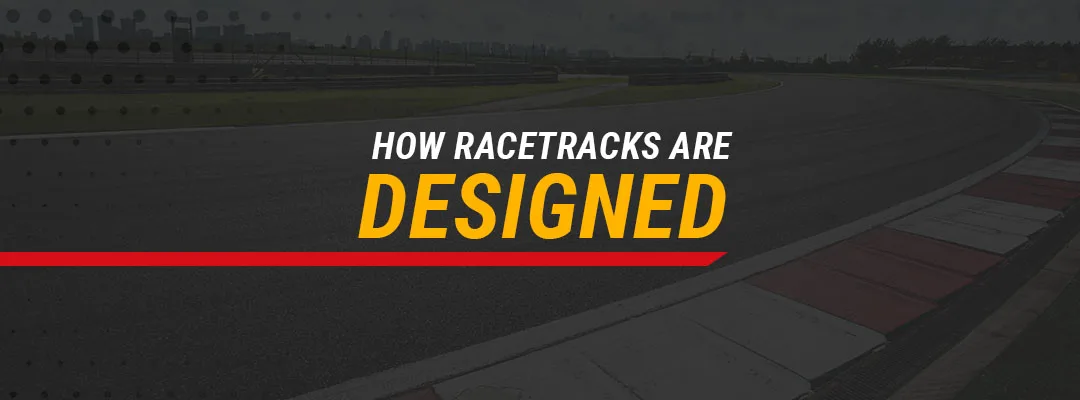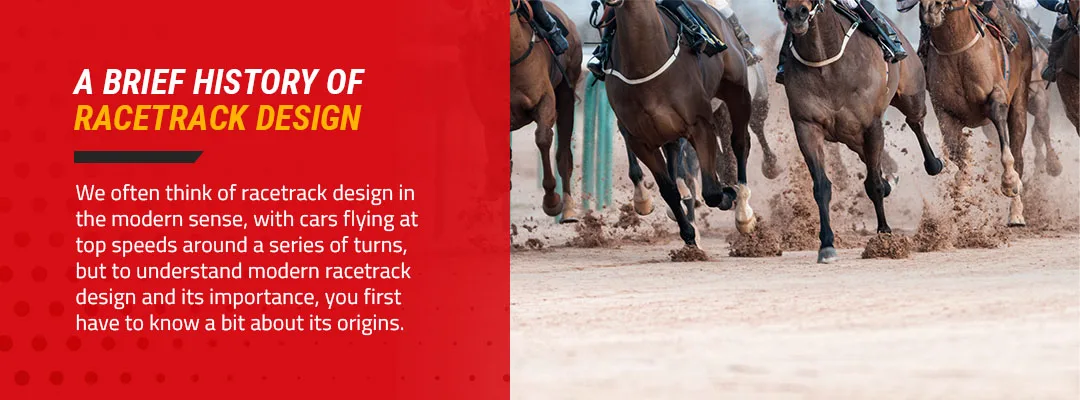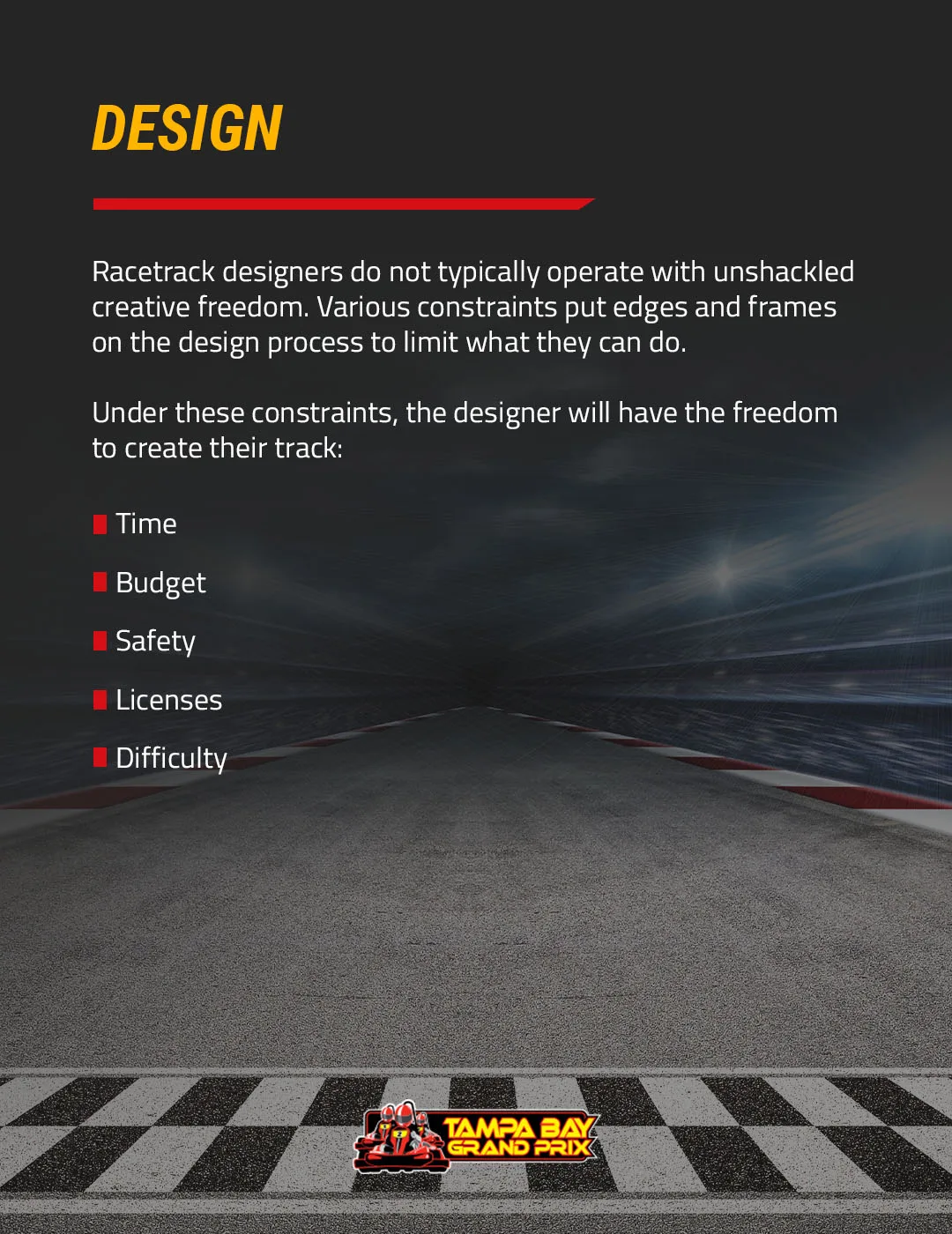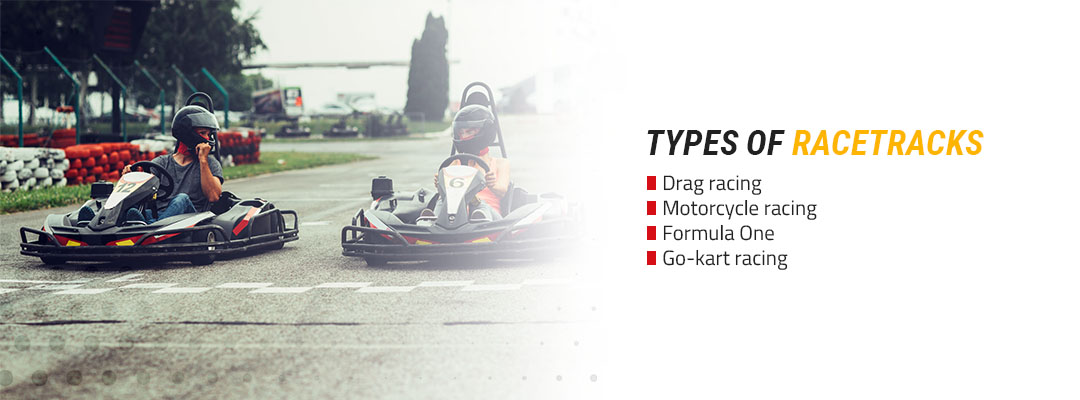How Racetracks Are Designed

When you see the familiar oval-shaped racetrack, you might give little thought to how it was designed and crafted. With a few turns and straightaways, how involved could it be?
Racetrack design is a complex process involving various steps, simulations and test trials. Tampa Bay Grand Prix covers the racetrack design process, with a brief background of its history, the different types of racetracks, and the steps to designing a track.
A Brief History of Racetrack Design
We often think of racetrack designs in the modern sense, with cars flying at top speeds around a series of turns. Designs actually started much earlier in civilizations that have come and gone. Since those first prototypes, the racetrack has evolved, becoming a more intensive, layered process with innovative technology guiding each step.
To understand modern racetrack design and its importance, you first have to know a bit about its origins.
Ancient Beginnings
Historians can trace the first racetrack design back to the 6th century BCE in ancient Rome. Referred to as Circus Maximus, the Romans built the racetrack for various uses, including chariot races. The track was 540 by 80 meters and covered in sand. There were twelve starting gates and an ornate, decorated barrier cutting through the track’s center.
Chariot racers were wildly popular. Though the winners did not receive monetary rewards, the racers — and the horses — would become crowd favorites for their outstanding performances. Winning a race could lead to an immortalized legacy. We still know and read about the histories of famous racers revered and adored by the Romans.
During its peak, Circus Maximus could hold a capacity of 250,000 spectators. Builders used concrete and stone for the lower tiers and wood for the rest. Emperors also used the track for other dramatic events, like public executions, animal hunts and the notorious gladiator fights.
Archeologists have since excavated the area and restored it to resemble its former appearance, but today it only hosts concerts and rallies. Circus Maximus was simplistic and popular, and it acted as the blueprint for the modern racetrack.
Horse Racing
The history of racetrack design wouldn’t be complete without mentioning one of the most significant influences — horse racing. As one of the oldest sports ever, horse racing history is almost too ancient to pin down its origins. It was held in the Olympic Games of Greece and was prevalent in many areas of the world.
Horse racing was extremely popular, inspiring the growth of betting and thoroughbred breeding for horses and racetrack design guidelines. The modern era of horse racing arrived in the 1700s and 1800s with the introduction of the classic games — the American and British Triple Crowns.
Early horse track designs were basic quarter-mile straightaways. Designs soon became longer and more involved to more pressure on the jockeys to strategize and pace their horses. A jockey had to know their horse and the track intuitively to decide when the best place was to get that extra boost of speed.
Horse racing popularized racetracks and started revolutionizing the designs, giving way to its modern form.
Motorsport
The invention of the automobile introduced an entirely new way to race, and with it came the modern sports and varied racetrack designs we see today. One of the first racetracks designed for automobile racing was built in 1906 in England. It was a 2.7-mile track, thirty feet wide with two banked curves. The famous Indianapolis Motor Speedway would be built three years later, opening as unpaved and only later filled in with brick. Many of the first racetracks in the United States were unpaved and covered with dirt.
The early to mid-1900s saw the rise of car racing as a sport. NASCAR was founded in 1947, followed by the National Hot Road Association, spreading to multiple countries.
From there, racetrack design and technology have become an art in itself, becoming more specific and detail-oriented with each passing year. The introduction of safety regulations has led to more emphasis on design features. Architects have to work within limited confines to build a track that has a good blend of difficulty, fun and safety.
How Are Racetracks Designed?
Since the introduction of Circus Maximus, designing racetracks has evolved and grown into an intricate process. Tracks are now as precise as ever — they merge old-fashioned concepts with breakthrough technology, and the architect has complete control over how it comes together. Each step comes with its challenges and is geared towards a specific skill set. There are a few steps that make a good racetrack.
Planning
The first step is the planning process. Usually, this involves a property developer or a track owner seeking out a company to make their idea a reality. Though the initial idea can be creative and enticing, it often revolves around the available land. In the initial stages, the designer will also determine several main aspects of the track using:
- Topography: One of the most important factors to consider when designing a track is topography. Are there hills? Is it relatively flat? The designer will have to cater to each bump in the ground and find ways to integrate the irregularities. Designers will want to know the ground material and if there are any streams to work around. Sometimes, designers want to integrate the track into the natural setting instead of wiping the area clear and starting from scratch.
- Function: Will the track be used for bikes? Cars? Karts? Determining the track’s function will impact its designs. There are racetrack safety considerations for each type, such as constructing run-offs for emergency purposes. Many designers try to make their track cater to a wider breadth of vehicles so many different types of drivers can enjoy it.
- Size: Figuring out the width and length of the track is a crucial, primary aspect of the planning stage. The purpose will again play a role here, catering to the vehicles that will be driving on it. Depending on the land, the design will have to suit those dimensions and use the area efficiently.
Once the plot of land is identified and the planning process has started, it’s time to get into the more specific aspects. Though many might see a standard circuit configuration, a designer can pull from various racetrack shapes. There are options concerning turns and inclines and small, seemingly tiny details that completely change the track.
Design
Racetrack designers do not typically operate with unshackled creative freedom. Various constraints put edges and frames on the design process to limit what they can do. In many ways, this is an advantage — it gives the designers a frame of reference and guidelines, creating a general strategy and routine that outlines the process. Under these constraints, the designer will have the freedom to create their track.
- Time: Developers will often have a date for when they want their track done. The shorter the duration, the more basic the track will have to be, or the faster the designers will have to work, leading to a rushed process and mistakes. When it comes to tracks, it’s usually better to take time to hammer out all the details so that all parties can be satisfied with the finished product.
- Budget: The amount of money available for construction is another crucial factor in any racetrack project. The budget will significantly impact the overall design process, so it’s essential to know what the budget is before planning for material costs.
- Safety: Today, safety is vital for racetracks. Governing bodies have regulations on tracks to help stop accidents from happening. Racers often move at extremely high speeds, so tracks are now designed to alleviate the many dangers associated with speed. Designers must understand these safety measures and construct a design with those in mind. You can create a complex, innovative design, but it will result in various fines and intimidate racers if it’s unsafe.
- Licenses: Before construction and sketching begin, designers will want to know the licenses they’ll need to build the track and any specific local laws or ordinances that could affect the process.
- Difficulty: The track’s function will affect the difficulty level. The difficulty will also cater to a particular target audience and its overall enjoyment. If a track is designed for Formula One racing, then it is being made for a specific niche, with cars operating on an advanced level. The track will have a different feel based on your vehicle, and those without a Formula One racing car likely won’t get the same enjoyment. It’s crucial to determine your target audience and identify who you want to use the track before sketching begins.
As you can see, designers have to consider many different aspects of racetrack design even before the actual drawings and renderings start. Once they’ve narrowed down the specifics, the fun can begin.
Sketches
With the list of requirements and design aspects at their disposal, an architect can start the initial sketches of the racetrack. In the past, these were literal hand-drawn sketches, but more recently, designers have started to use software to draw up these designs. The racetrack design software lets them show progress to their clients in real-time.
Basic racetrack components are added to the designs, such as pit buildings, which give more shape to the track and help designers get another frame of reference.
Simulation Testing
One of the more fascinating parts of the racetrack design process is simulation testing. After the creators draw up the initial sketches, special designers — sometimes known as visualizers — bring the track to life digitally. Visualizers can take sketches or finished designs and implement them into software programs, creating architectural renderings on the screen.
Designers then input their work into a simulated game engine, where you can import a track and a car and test it out in virtual reality. This software gives creators an authentic driving feel to the track, showing how the design will play out in real life.
Construction
Racetracks are made through a detailed construction process. Once a design is complete, the designers and contractors can start working on plans for the tracks. Companies will often work with local government to ensure they’re following local laws, and companies will hire builders to carry out the designs. These builders will bring the track to life, and racetrack development will likely be complete within months.
Types of Racetracks
Each racetrack typically has a specific sport and target audience in mind. Some common targets for racetracks include:
- Drag racing: This sport usually consists of a simple straightaway from a standing start — the first to cross the finish line wins. You can drag strip race in multiple vehicles since the concept is straightforward.
- Motorcycle racing: Motorcycles operate entirely differently than traditional vehicles, making their track designs unique. Motorcycle racing is another beloved racing sport.
- Formula One: This racing style includes some of the fastest, most performance-driven cars on the market. Tracks for this type of racing will be especially unique and geared towards a specific niche of drivers.
- Go-kart racing: Some tracks are not designed specifically for professional racing. Designers can gear them towards a fun experience that also includes skill. Go-kart racetracks are extremely popular and offer a racing style that anyone can enjoy. These racing circuits are usually smaller and provide sharper turns than traditional tracks.
About Our Tracks
Are you looking for a go-kart track to test out your driving skills? Tampa Bay Grand Prix offers some of the best racetracks in Tampa Bay. With Italian-manufactured go-karts that can reach a top speed of 50 mph, see your lap time as you pass the projector screen and battle your friends for the best times.
Our Clearwater racetrack has a Grand Prix track that is great for the family or those looking to improve on their times. Whether you’re looking for fun or a challenging time out on the track, Tampa Bay Grand Prix can help you go fast and have fun.
Book a Race Today
Many Formula One drivers honed their craft on go-kart tracks by improving their driving skills and striving to beat their times. Tampa Bay Grand Prix fosters competitive drivers and constant improvement. Our tracks are unique and specially crafted for fun, safety, and challenge. We host league racing, events, and parties, corporate events, and more, so everyone can take a turn behind the wheel.
We’re your place to race. Contact us today!




